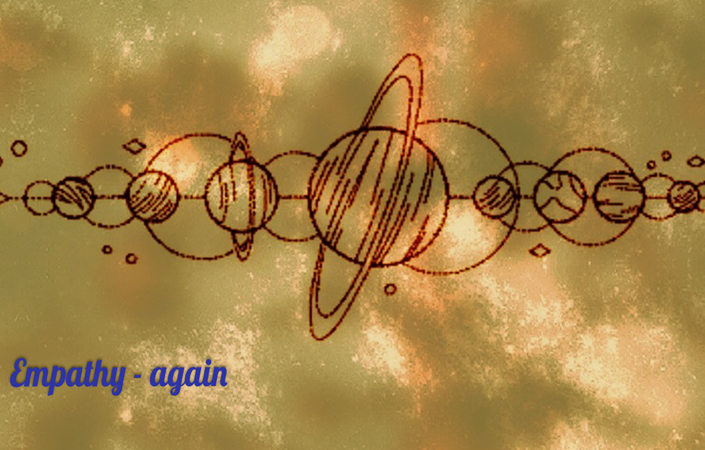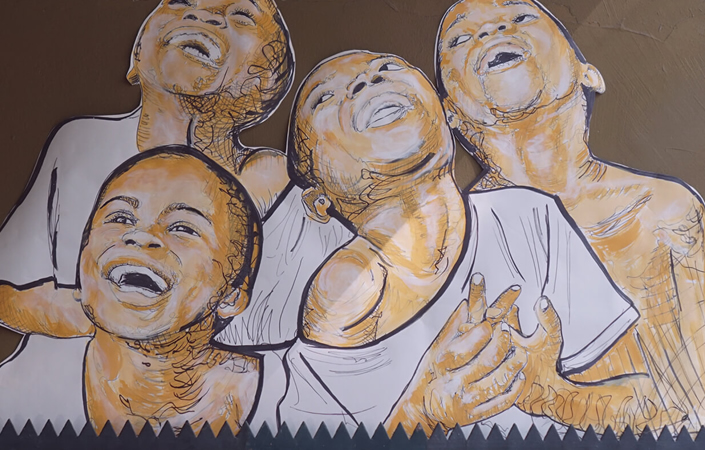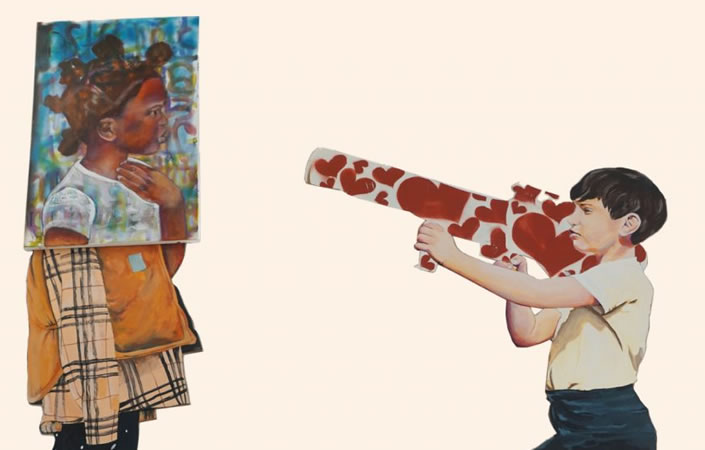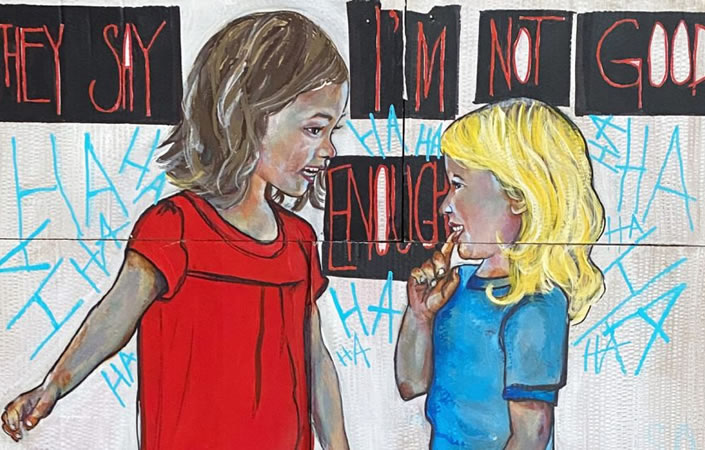4. February 2022

There is a lot of talk about empathy as a leadership trait. Empathy is thus primarily located in the process of communication between people. However, empathy has another, essential dimension, which also places it at the center of strategy development.
We are now increasingly and acceleratingly confronted with non-linear dynamics – be it in the markets, in the global political situation, in the needs of the customer groups relevant to us, in social developments, to name but a few. Our cognitive analytical tools for describing this reality and its future (even near future) developments are no longer sufficient for predicting and guiding in these dynamic non-linear systems prone to disruptive events. The high degree of interconnectedness with its upsurging, circling dynamics within our communication streams sets limits to dominantly rationally oriented strategy work.
As a necessary supplement, the ability to empathize is required not only of single individuals, but of social systems, be it companies, administrations, NGO’s, religious organizations, generally of all social systems. Empathy is here the ability to feel resonance patterns of our direct and indirect environment, in short we need the empathy ability of a collective. In addition to open internal communication and reducing value judgments, the empathic resonance capacity towards a dynamic environment can only succeed if the collective is diverse – encompassing all criteria of the diversity perspective, if possible.
Synnecta’s work with groups has always aimed at the development of collective empathic capacity and has been further strengthened in recent years around the open experience of always given diversity. However, the still large homogeneity of leadership groups sets a limit to the ability to resonate with non-linear dynamics and thus also narrows the strategy work.
Rüdiger Müngersdorff
9. November 2021

Throughout its long history, the Western world has returned time and again to the same demand: there must be a sense to your life, your existence must have a purpose that goes beyond the measure of life itself. Viktor Frankl has it that this can be something quite individual, but mostly, we are asking for something bigger, something that traverses a whole life. In national movements, for example, it has even gone as far as self-sacrifice. Children are already confronted with the need to declare a purpose in young years: »And what are you going to be one day?« Be useful! Fill your life with a task, a purpose. The message remains the same: What are you doing this for? What is the purpose? What is the sense? Life itself is not enough, it has to relate to something else, something greater.
As purpose concepts are gaining ground, they are pitching that demand right into the heart of businesses. They emphasize their claim: Pick a task, have a purpose! Choose an employer who also has a greater purpose. Be part of a community of sense. The core message is that a successful, fulfilled life must be borne by a purpose. Once you find yourself in your community of purpose, you will be motivated and engaged. That sounds good.
There is a flipside, though, which often leads to disappointment, fatigue, exhaustion, even a sense of failure. The need to have a purpose in life turns into an interior demand, an obligation. In other words: Justify yourself
The need for self-justification is one of our deepest individual and collectively shared beliefs. It calls upon a higher instance: a judge to whom we have to justify ourselves. In our individual lives, that role is often given to our parents. Casting a wider arch, it becomes increasingly unclear who will even pass that judgement.
What is it that we have to justify? First, we need to justify the sense, the purpose that we have given to our life or that has been given to us. Is my purpose a good and valuable purpose against an exterior measure? We ask that question of ourselves, but nowadays also of companies: does the business serve a good purpose, is it borne by a sense that transcends its mere task of being an economic success? This is the first step of justification. It leads to a second justification: Do I, do we fulfil our purpose? Once again, we are facing a judge and a jury. (Add to that the images of our culturally shaped background: it’s about heaven or hell.)
In my coaching work, I often encounter people who despair at this obligation and the expected judgement. They lose their joy in life and in existence against the backdrop of the judge’s ruling that they are foreseeing. When coaching addresses mindsets, it creates an awareness for these demands for a purpose. It also lets us experience which judges we effectively project in order to reinforce this life obligation.
A look at the role of CEOs reveals that the jury is cast so much more widely today. While justification used to be due only to the shareholders, it is now also owed to employees and to society. Those are quite differing scales.
The need to justify our life and our actions is surely an opposition to arbitrary selfishness. However, it can also dampen lively spontaneity, stop us from doing things for the sheer will to do so and obscure our own imagination as part of innovative action. Günther Anders posed a question that provides a fine reason to take a closer look at our own landscape of self-justification.
»Why do you suppose at all that a life might have to contain something else than just being, or even that it is possible for life to have such another thing – the very thing you call a purpose?«
(Günther Anders in Die Antiquiertheit des Menschen)
#myndleap #mindset #mindsetarbeit #mindsetcoaching #kollektivesmindset #synnecta #denksinnlich
Rüdiger Müngersdorff
This article was first published at www.myndleap.com
© Artwork: Mitra Art, Mitra Woodall
3. November 2021

Shifting the Meaning of Leadership Roles: Thinking Leadership from the Employee Perspective
1. How does the meaning come to be shifted?
The Western world has some specific cultural patterns. One of these calls out to us already from the Story of Creation in the Old Testament: »…replenish the earth, and subdue it!«, and it paints an expectation of pain and suffering. We are called upon to be doers, designers, movers. That is the core of the leadership role: design, do, create. Our modern experience of a global, networked world and its dynamics, as well as the confrontation with other cultural assumptions and values casts doubt on our notion of a confident, designing subject who has been given the world as a creative space. The modern experience appears different: it is not us who subdue the world, but the world that subdues, even overwhelms, us. Instead of scaring us off, though, this insight makes us look for new ways of finding a balance between designed influence and acceptance of the fact that the world shapes us as much as we shape it. It is an experience that also shapes our notion of leadership: the confident role taken on by a designing manager is being challenged by the potential of leadership by collectives.
We have reached a point where we are more likely to describe a manager as someone who enables, sponsors, moderates. We speak of serving managers with the values of humility and caring. It is the path from a strong ego to being part of a greater community.
It appears as if the manager of old had surrendered in the face of complexity, contingency and acceleration. That kind of leadership can no long fulfil the role of the knowledgeable designer and is facing the limits of its own confidence. Hence an answer is sought in the potentially more powerful and more intelligent collective and its multitude of voices. We trust in the wisdom of many views, different discourses and we believe that the collective as a group with a range of perspectives is more likely than the old manager-hero to succeed at the complex tasks of the modern world.
This development goes hand in hand with an insight that the Western dominant model that everything has a reason and can be based on a cause is powerful, but not universally applicable. A complex, accelerating and dynamic world teaches us to look at events in a systemic way: we view events as interactive and interwoven conditions in which we cannot find a single, unmistakeable cause, but instead find networks that might have caused the event we are seeking to explain. Knowing a single cause shows us a single goal-oriented path of action. A network of relationships forces us to follow feedback whatever we do, to become part of the network, to learn to live with the network. (Hence the altered understanding that mistakes, by triggering feedback, are an opportunity to learn.)
2. Has the old leadership role become obsolete with the turn towards the collective?
In order to master the challenges we face, to find an answer that serves the whole, we surely need the many voices of a diverse collective: we need open discourses without fear. For these discourses to be successful and the many voices not to get stuck in unforgiving positions, we also need guides, an orientation and the ties to a common horizon for whatever is needed at that point. It remains the leadership task to provide orientation, carrying the entire risk of having been wrong. Leadership must surely learn to accept that the subject is not the mighty centre but a part of the whole with a very specific role in that whole. It is always a painful task to learn that I am limited and restricted and that the path to overcoming that limitation are the others. There is another old adage that has accompanied the Western people, passed on by an Ancient Greek oracle: Remember, you are a human! Only a human, but also a human. Hannah Arendt attributed to these humans the ability to make a start. That also remains a leadership task.
3. Is the collective ready to assume leadership tasks?
In many years of working in group dynamic settings, I have seen how difficult it is to attain common orientation and goal-oriented cooperation in groups that lack leadership. In addition to the known group effects (finding roles, positions and meanings in a social field – emotionally driven effects), the development of collective, limiting patterns of perception, thinking and decision-taking form the greatest barrier to a multi-perspective and open dialogue. Together with the emotional dynamics of group cohesion, it reduces the opportunities of multiple perspectives, shrinking the group into – usually subconscious – groupthink. Without directed work on these limited patterns, groups stay far below their level and cannot achieve their given task: to better manage complexity. The dynamics of groups keep covering up the factual focus and, as psychoanalysis described for individuals, access to the collective mindset as a subconscious entity is boarded up by many defence mechanisms. This is why working with the collective mindset requires a deep expertise in group dynamics. It is the only way to manage the new balance in leadership: a more productive balance between leading and being led.
#myndleap #mindset #groupdynamic #collectivemindset #newleadership #synnecta #denksinnlich
Rüdiger Müngersdorff
This article was first published at www.myndleap.com
© Artwork: Mitra Art, Mitra Woodall
5. July 2021

Group dynamics are at the root of all work with social systems. There is a myriad of methods to use in trainings and workshops in order to cover these dynamics. They are effective as long as the issues at hand remain in the foreground and in everybody’s joint focus. However, we frequently find what we call relationship topics gaining ground and hindering progress on the so-called factual topics. Nowadays, as positivity is the prevalent group norm, it has become the habit to not only methodically isolate these dynamics, but in fact to expel them from the groups’ communicative dynamic. At the same time, we know that groups are such rich environments only because of the difference, the range of perspective, opinions and attitudes. This wealth is only accessible where emotions are also admitted. Emotions are too frequently considered dangerous and disruptive, even though they are the very thing we need in order to give difference and diversity scope for effect. We are often lacking the required emotional sovereignty. The habit of ignoring and suppressing group dynamics becomes more pointed in the context of virtual, digital work. At first sight, all conflicts, differences and blind spots seemed to have disappeared in that context, but by now it is apparent that they were in fact only hidden – one sign of this is not least the dwindling enthusiasm in virtual conversations. Another indicator for the fact that it is no solution to ignore the emotional side is the growing number of psychological illnesses and burn-out symptoms reported by the health services.
I often see mindset work concentrating on the individual. There is a promise that we can break free of the binds of mindsets we have collected during our life histories and thereby develop greater degrees of freedom in our actions. That does not go far enough. Mindset work also takes place with a person – it happens within a relationship, in a social situation. This social scene is a fundamental aspect of its efficacy. Taking a closer look, coachings in small groups turn out to often be more efficient than one-on-one relationships, because they work in a much more elaborate social space, a richer scene. Group dynamics are so very important precisely because productive work on the collective mindset is work with the social scene. However, those very skills on group dynamics are often lacking: mindset work that relates to collective understanding and cultural factors is still in its infancy.
We live and work in groups – we are always in a social situation. This setting inspires us and opens our own necessarily limited a priori understanding. While it does create openness, however, it also draws boundaries. The boundaries that are typical for groups are often called groupthink. The usually subconsciously effective norms and rules of behaviour within groups define a space or a scene that effectively limits individual impulses and perspectives. The multitude of individual voices is reduced within groups.
Groups have the potential to be enriching, to have many voices, many facets, and therefore to be able to perform better and adapt more easily, to be more agile. It is rare that this potential is productively tapped. Why is that so? Groups very swiftly form a system of norms and assumptions, values and expectations, which effectively reduce the scope for individual perspectives. Social beings have a need, the necessity to belong, to be part of a social system and thereby also a fear of not belonging, of being excluded. There is great pressure to fit in. We often find ourselves succumbing to that pressure subconsciously or under the cover of excuse stories. Without consciously wanting to, we act, speak and engage in a way we believe to be the group norm.
In doing so, we are robbing the group of its greatest potential: the diversity, the differences, the strangeness and otherness, in short: its individual perspectives. Watching groups, we always see that a limiting norm wins out. The simplest methods in use to that extent are to point out a lack of time or, currently very much en vogue, the request to keep displaying a friendly, accepting Yes Set.
The collective mindset, the organizational development or group culture have an effect on individuals in their belonging to groups and organizations: reinforcing, weakening, shifting. The collective is often more persuasive. Whereever we are dealing with a priori assumptions that shift an individual’s tenets, we must work with the social scene in which that human being lives and works. Individual actions are greatly defined by the scene in which we are set or have set ourselves. Groups provide us with a scene as well as a script that tells us how to play that scene. We seek to niche ourselves within that script: to find those roles which we consider most like to to give us a good position within the community of this group or this social organization. In doing so, we frequently abandon our own personal wealth without even noticing it and are by that very act robbing the group of its own greatest potential: the difference, the individual perspective.
We all have an individual a priori understanding with which we encounter the world and which is each our very own. Where we are part of a social system, we also have a collective a priori understanding that we share with others, with our group. The collective mindset (a priori understanding) is often the more dominant one. The desire to belong and at the same time the fear and shame of exclusion lead us to adapt. We are often not aware of the price we pay for that until the evening, when we are alone. (This is why it remains vital to include at least one evening and one night in workshop designs. They provide the spaces where impulses emerge that can trigger movement. The prevalent abbreviation of meetings, trainings and workshops is one contributing factor for the dominance of the collective norm and the exclusion of difference.)
The collective and the individual mindset are connected. They form a dynamic system and tend to balance out in a limiting stability. Effective work on the individual and the collective mindset works at this balance, opens differences and therefore makes movement possible. At the outset, it is important to perceive the scene that is provided by a group; this makes it possible to engage in different versions and therefore facilitates that differences are made visible and can be discussed. The key to change is opening the group’s expressive sphere, perceiving cracks in the group’s evaluations. This is where the potential of the members can enter group communication and have a differentiating effect. For that to happen, the people must be ready to reveal themselves and develop a setting of trust where differences are accepted (psychological & emotional safety). Group dynamics are about trust as much as the readiness for confrontation. Anyone who supports cultural change in organizations knows that sustainability can only be achieved when both poles of the balance, individual and collective, are worked on at the same time.
This is a plea for group dynamics, then. Any effective work with the mindset concept necessarily demands a deep familiarity with group dynamics, the lived roles within the groups and their mutual influence is essential.
Group dynamics go beyond moderated, directed conversation. They open up towards a wealth of individual, diverse, multitudinous perspectives.
At the same time, this path leads to the ability to repeatedly take decisions that are fit for the contingency and complexity of our modern world of life and work. Wolfgang Hegewald has described what we need in order to achieve that: »(…) that art and society base themselves on difference, on a curiosity about the Other and a sympathy for what I am not, a desire for change, for rhythm and distance. That my heart beats for my mind: an erotic experience.«
#myndleap #mindset #mindsetcoaching #organizationaldevelopment #synnecta #denksinnlich #collectivemindset
Rüdiger Müngersdorff
This article was first published at www.myndleap.com
© Artwork: Mitra Art, Mitra Woodall
28. June 2021

When Arnold Gehlen described humans as insufficient creatures, he furnished this label with a positive interpretation. The human ability to design our life world grows out of the physical insufficiency of humankind, essentially establishing a dominance within it and an ability fashion it out of the very needs of that insufficiency. This anthropological approach is juxtaposed by a psychological definition of insufficiency in the ontogenetic development of humans with messages that communicate to the individual: You are not good enough! In this case, the state of insufficiency is often frozen in time, arrested without achieving the turn toward design, domination and overcoming. The messages of lack result in resignation, doubt, giving up or an eternal fight against the power of the early messages.
Messages of insufficiency are part of our societies’ cultural attitudes. They play an important role in families. In biography-based work that addresses the proverbs children and young people remember having often, time and again, heard from important attachment figures, it becomes apparent how these messages evolve into attitudes and tenets. ‚Life‘s no picnic‘, ‚No pain, no gain‘ or the at first sight less threatening ‚No sweet without sweat‘: they all convey the same message, namely that the recipients are not good enough, need to deliver more, pull themselves together. The world is not a place of experience and blissful design, it takes the shape of a permanent practical test. There are indeed also messages of power, fulfilment and an awareness of one’s own potential. While both facets are there, the balance is often not right.
This missing balance that is so frequently encountered is often met with the recommendation to form formulaic positive resolutions. Although this can have a positive and stabilizing effect on individuals, it is clearly not enough.
Mindset work as realized by MyndLeap addresses the phenomenon where culture, collective mindsets and individual mindsets meet and develop particular dynamics. Any work that focuses only on the individual and that individual‘s belief systems will not alter the ties between such normative cultural messages and the individual’s related tenets.
Ideally, these very ties will reveal differences and thereby open up a space where an altered narrative can emerge. This altered narrative sees that mistakes are elements of innovation and can thereby change the perfectionist norm so that individuals can find a space in which to fashion their own designs, interacting between the fields of ‚I can do it‘ and ‚I am not good enough‘. The narrative that mistakes are an integral part of the process of learning and growing is still strongly juxtaposed by the narrative that mistakes are wrong in themselves, must be avoided and constitute a nigh-on moral failure. There is often a mutually reinforcing symmetrical relationship between collective and individual tenets. This relationship can unfold a great reciprocal power where the belief systems communicate safety, the ability to design, courage and the joy of a challenge. The opposite is true, however, when tenets of insufficiency reciprocally reinforce each other.
Looking back at the origin of the mindset concept, it becomes apparent once more that it really addresses specific assumptions towards the world that are inherent to social systems and predate any concrete experience. It began by focussing on social classes and moved on from there to the investigation of whether there are typical national mentalities. The pivotal question for us today is in what way the mentality or the dominant collective mindset have a significant effect on the enthusiasm and the ability to perform among company employees. While individual mindset work can be a relief for each individual and often shows a path out of a situation that stabilizes and reinforces a person‘s own awareness of their insufficiency, organizations must tap into the collective mindset here. This is the lever for change. There are tried and tested methods that permit groups as well as larger organizations to work in such a way that it is immediately apparent how the collective mindset works and which normative messages it sets. The individual beliefs work within those normative messages. As soon as the connections are made apparent, it is possible to begin a process that lets in other messages and eventually makes them effective by sustainable, mindful awareness and integration. Cultural patterns establish themselves by repetition, modelling and imitation. The work on the collective mindset as designed by Myndleap leads from an awareness of insufficiency to an awareness of potential. It can therefore tap into a culture of potential within which each person can take it into their own hands what to make of that potential.
#myndleap #mindset #mindsetcoaching #organizationaldevelopment #synnecta #denksinnlich
This article was first published at www.myndleap.com
© Artwork: Mitra Art, Mitra Woodall





